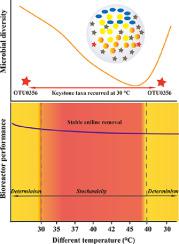Water Research ( IF 11.4 ) Pub Date : 2022-06-13 , DOI: 10.1016/j.watres.2022.118741 Hui Chen 1 , Zhu Chen 2 , Xueyan Chu 1 , Yan Deng 1 , Shengqiang Qing 1 , Chongran Sun 1 , Qi Wang 1 , Hongbo Zhou 2 , Haina Cheng 2 , Wenhao Zhan 3 , Yuguang Wang 2

|
Seasonal temperature changes significantly affect microbial community diversity, composition, and performance in wastewater treatment plants. However, the community assembly mechanisms under seasonal temperature variations remain unclear. Here, we carried out temperature cycling experiments (30 °C, 35 °C, 37 °C, 40 °C, 42 °C, 45 °C, 40 °C, and 30 °C) to investigate how temperature impacts microbial performance and co-occurrence network and how assembly processes determine the structure and function of microbial communities during treating aniline wastewater. During the 195-day operation, the system achieved an efficient and stable aniline removal of 99%. Interestingly, α-diversity and network complexity were negatively correlated with temperature but could be recovered when the temperature was returned to 30 °C. The results showed that functional redundancy was probably responsible for the excellent microbial performance during the whole process. Null model analyses presented that deterministic process dominated the community when the temperature was 30 °C, and stochasticity dominated the assembly process when the temperature was over 30 °C. Overall, the balance between stochastic and deterministic processes in the treatment of aniline wastewater mediated the reoccurrence of microbial community and co-occurrence network at different temperatures. This study provides new insights into microbial community reoccurrence under seasonal temperature changes and a theoretical basis for regulating microbial communities in wastewater treatment plants.
中文翻译:

温度介导了苯胺废水处理过程中随机和确定过程之间的平衡以及微生物群落的重现
季节性温度变化显着影响污水处理厂的微生物群落多样性、组成和性能。然而,季节性温度变化下的群落组装机制仍不清楚。在这里,我们进行了温度循环实验(30°C、35°C、37°C、40°C、42°C、45°C、40°C 和 30°C)以研究温度如何影响微生物的性能和共现网络以及组装过程如何确定处理苯胺废水过程中微生物群落的结构和功能。在 195 天的运行中,该系统实现了 99% 的高效稳定苯胺去除率。有趣的是,α-多样性和网络复杂性与温度呈负相关,但当温度恢复到 30°C 时可以恢复。结果表明,功能冗余可能是整个过程中微生物表现优异的原因。零模型分析表明,当温度为30°C时,确定性过程主导群落,当温度超过30°C时,随机性主导组装过程。总体而言,苯胺废水处理中随机过程和确定过程之间的平衡介导了微生物群落和共生网络在不同温度下的重现。该研究为季节性温度变化下微生物群落的重现提供了新的见解,并为调节污水处理厂的微生物群落提供了理论基础。零模型分析表明,当温度为30°C时,确定性过程主导群落,当温度超过30°C时,随机性主导组装过程。总体而言,苯胺废水处理中随机过程和确定过程之间的平衡介导了微生物群落和共生网络在不同温度下的重现。该研究为季节性温度变化下微生物群落的重现提供了新的见解,并为调节污水处理厂的微生物群落提供了理论基础。零模型分析表明,当温度为30°C时,确定性过程主导群落,当温度超过30°C时,随机性主导组装过程。总体而言,苯胺废水处理中随机过程和确定过程之间的平衡介导了微生物群落和共生网络在不同温度下的重现。该研究为季节性温度变化下微生物群落的重现提供了新的见解,并为调节污水处理厂的微生物群落提供了理论基础。苯胺废水处理中随机过程和确定过程之间的平衡介导了微生物群落和共生网络在不同温度下的重现。该研究为季节性温度变化下微生物群落的重现提供了新的见解,并为调节污水处理厂的微生物群落提供了理论基础。苯胺废水处理中随机过程和确定过程之间的平衡介导了微生物群落和共生网络在不同温度下的重现。该研究为季节性温度变化下微生物群落的重现提供了新的见解,并为调节污水处理厂的微生物群落提供了理论基础。









































 京公网安备 11010802027423号
京公网安备 11010802027423号